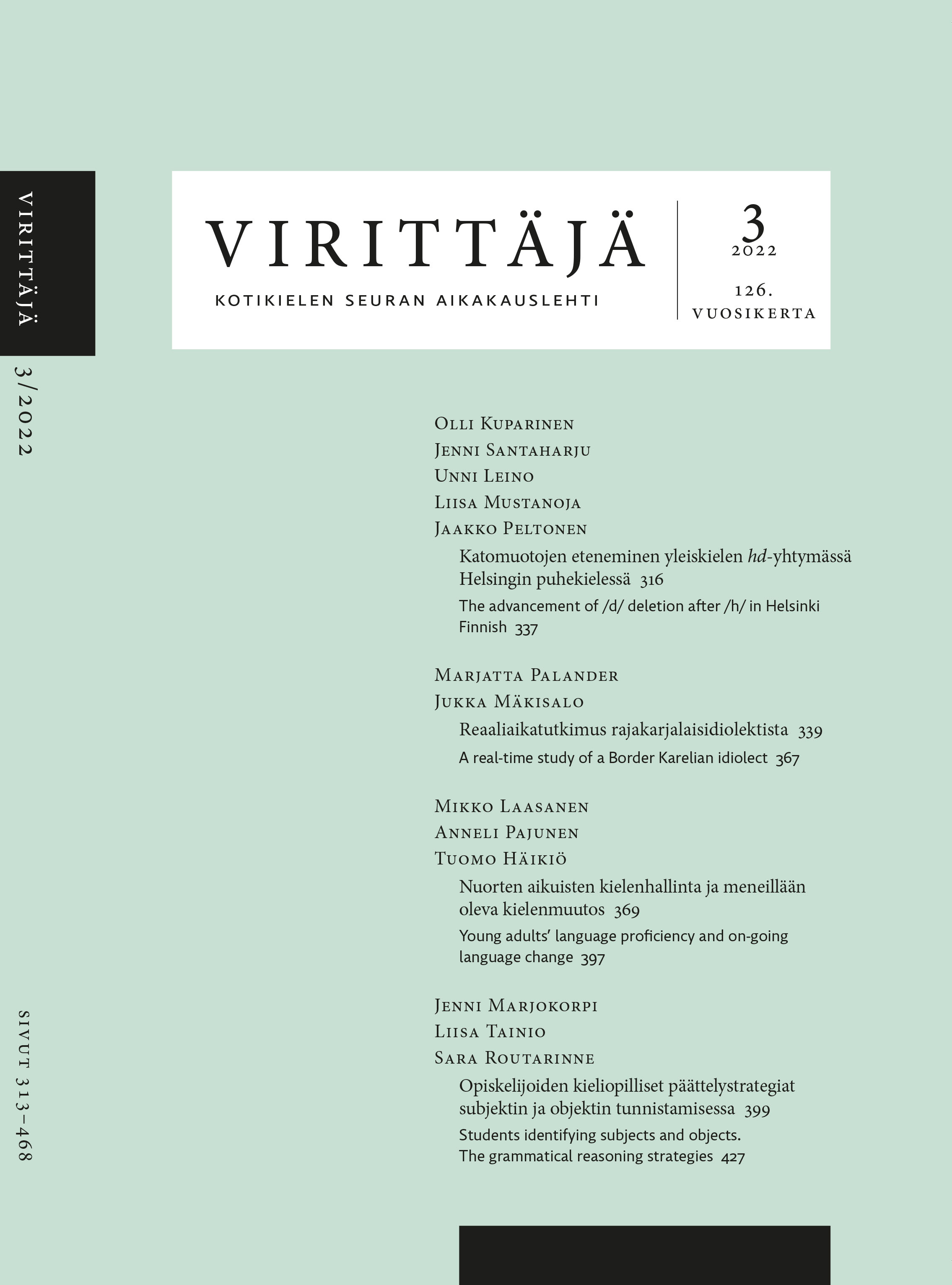Reaaliaikatutkimus rajakarjalaisidiolektista
Abstrakti
Artikkelin aiheena on tapaustutkimus, jossa sosiolingvististä reaaliaikamenetelmää sovelletaan vuonna 1900 syntyneen rajakarjalaistaustaisen naisen puhekieleen. Seuruun kohde syntyi eteläkarjalan puhuma-alueella Venäjän Porajärvellä, mistä hän muutti 17-vuotiaana Raja-Karjalan puolelle Ilomantsin Liusvaaraan. Toisen maailmansodan jälkeen hän asui nykyisessä Ilomantsissa savolaismurteiden alueella. Aineistona on noin seitsemän tuntia arkistoituja haastatteluja 18 vuoden ajalta (1960–1978), jolloin haastateltava oli jo eläkeikäinen.
Tutkimuksessa tarkastellaan 13:n äänne- ja muoto-opillisen piirteen edustusta kvantitatiivisen variaationanalyysin keinoin. Tavoitteena on selvittää, miten karjalaisina piirteet ovat säilyneet, onko edustuksessa havaittavissa ajallisia taitekohtia ja mistä mahdollinen vaihtelu voisi selittyä. Kaikissa tutkittavissa piirteissä on vaihtelua karjalaisten ja suomalaisten varianttien kesken koko tarkastelujakson ajan. Tilastollisesti merkitseviä eroja syntyy erityisesti vuoden 1964 näytteen suomalaistumisesta sekä vuosina 1975–1978 karjalaisuuden vahvistumisesta. Vuoden 1964 suomalaistuminen koskee varsinkin fonologisia piirteitä, joihin puhujan kontrollin voi olettaa kohdistuvan herkemmin kuin sijamuotoihin tai verbintaivutukseen.
A real-time study of a Border Karelian idiolect
The article focuses on a case study in which the sociolinguistic real-time method is applied to the spoken language of a female informant, born in Border Karelia in 1900. She was born in Porajärvi, Russia, which belonged to the South Karelian speaking area. When she was seventeen, she moved to the village of Liusvaara in Ilomantsi, Border Karelia. After the Second World War, she settled in present-day Ilomantsi, which is situated in the Finnish Savo dialect region. The material in this study consists of ca. seven hours of interviews, archived between 1960 and 1978, when the informant was already of retirement age.
In this study, the variation of thirteen phonological and morphological features is quantitatively analysed. The aim of the study is to explore how these features have retained aspects of the Karelian language, whether there are temporal turning points in the representation of these features, and how such potential change can be explained. During the whole period of eighteen years, there is variation between Karelian and Finnish with regard to all of the features involved. In 1964, the significant differences concerned the change towards Finnish but later on, successive samples show changes towards Karelian. The change towards Finnish in 1964 notably involved phonological features which are presumably controlled by the speaker more easily than cases or conjugations.
Temporal variation may be explained by the speaker’s phases of life: particularly in the 1960s, contact with speakers of the Savo dialect increased. As she aged, the informant returned more markedly to her native Karelian dialect. The study supports previous sociolinguistic findings regarding the propensity for idiolectal change throughout a person’s lifespan, and suggests that in old age speakers often return to the dialect of their youth.






